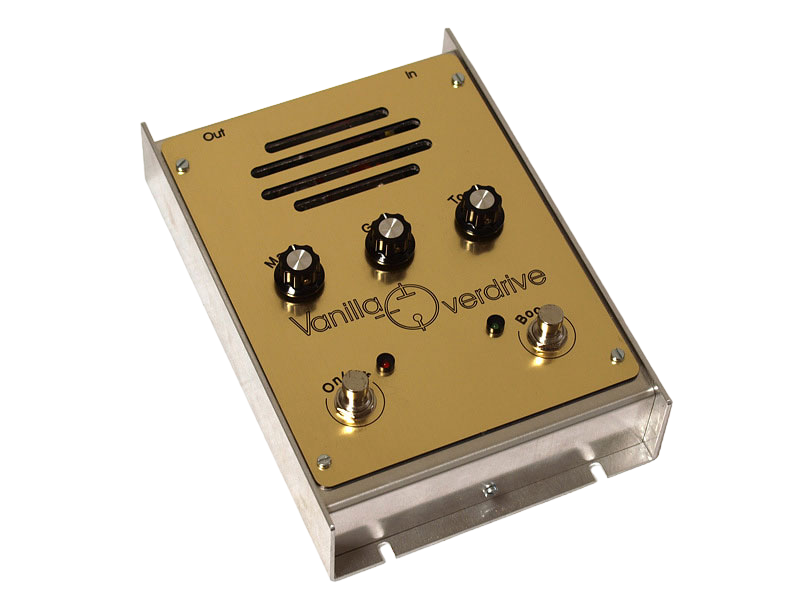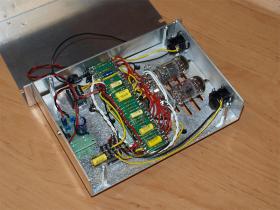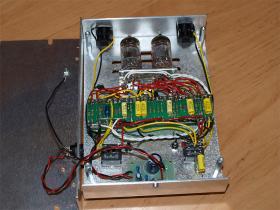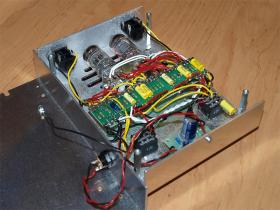
Vanilla Overdrive MKIII

Vanilla Overdrive MKIII
Note: This version of Vanilla Overdrive is no longer supported and is only online for historical reasons. If you are interested in the Vanilla Overdrive, please use the new version Vanilla Overdrive 60.
Originally conceived for tube beginners, the LoV Projects began several years ago with the Vanilla Overdrive. With the 2012 MKIII version, the Vanilla has developed into a flexible tube overdrive preamp, which stands up well when compared to commercial products.
The heart of the Vanilla Overdrive consists of two 12au7 tubes, running with an unusual, but safe, 12V plate voltage.
The circuit itself is nothing unusual and contains no “mojo” – only a few adjustments of the basic components to account for the low voltage.
The input stage of the MkIII has been modified. It is “always on” and now includes a simple boost function in the form of a switchable bypass capacitor. This means the boost function is available in both overdrive as well as bypass mode.
The tone-shaping circuitry has been reduced to a simple but effective tone control, as found in some Marshall amplifiers. The tone control leads to less signal loss, important in a low-volt project where the signal level is low to begin with.
Since normally the Vanilla will be used with a “normal” amplifier, which probably has its own more extensive tone stack, this is to be seen as a step forward, as often less (as in knobs) is more (as in tone).
So as to have enough signal, and to overdrive that signal more strongly than in the previous versions, a JFET has been added to the MkIII, placed immediately after the tone and drive controls, and which produces a significant gain boost. The purists will have to forgive us, but sometimes compromises have to be made, when they make sense and produce the desired results. The BF24 doesn't hurt, but those who don't want any sand at all can omit the red part of the circuit and connect the output of the drive pot directly to the grid of the following tube stage – but, as mentioned, this will lead to a significantly lower signal level.
The blue voltage values in the schematic are approximate values – real measured values should be similar, though not necessarily identical, with a 12.6V supply (assuming no errors have been made building the pedal). If a lower supply voltage is used, proportionally lower values can be expected.
The last stage is a cathode follower, resulting in a low-impedance output so that the Vanilla Overdrive can be used with long cables without noticable signal degradation. A 10 m cable is no problem anymore.
The overdrive sound itself is thick and full with stronger mids than the previous version. Perfect for dirty blues and rock sounds, and the 'boost' function produces an added kick for leads.
Construction
Even though the LoV projects are conceived for beginners, and 12V is harmless, the effort and skill required should not be underestimated, and these projects are not really suitable for absolute beginners in electronics. A basic electronic knowledge is required, especially in use of a voltmeter, as well as reading and understanding schematics. “Soldering by the numbers” – even when the layout appears to be quite simple – usually has a bad end. Furthermore, the enclosure is very tight, and presents certain requirements and challenges regarding handling a soldering iron. 100 watt soldering guns should be kept away from this project. The best results are obtained with a fine tip and a temperature between 350 and 370 degrees.
Powersupply
The power supply has also been reworked. The standard LoV power supply is still used, but several minor modifications have been made to fit a variety of voltage sources. In the beginning, a 14-15V transformer was used, which worked quite well. At some point, this unit was no longer available, and the alternatives were of inferior quality. Furthermore, we are again and again confronted with the fact that 230V mains are not universally 230V. Some areas of Europe have a significantly lower voltage, which can affect the tube filaments and thus the function of the tube – especially when a “simple” transformer is used. A switching power supply can work with a wide variety of mains voltages, but for the most part they generate very annoying interference, requiring (at least for the plate supply) some additional filtering before such a power supply can be used.
But – no problem. In the following schematics, three alternatives for the LoV power supply are shown, which will provide an optimal supply for the respective wall warts. Of course, with a 12V switching power supply, the plate voltage will sit at about 10.5V, but the Vanilla Overdrive works with this voltage, too, and the plate voltage is stable.
Possible Problems
The Vanilla Overdrive can be purchased as a kit, or the parts can be individually purchased and assembled. If the parts are individually selected, JJ tubes should not be used for this overdrive. For whatever reason, the JJ 12AU7 (as well as the JJ 12AT7) works very poorly or even not at all with the given plate voltages. Russian and Chinese tubes work – at least so far – without problems.




